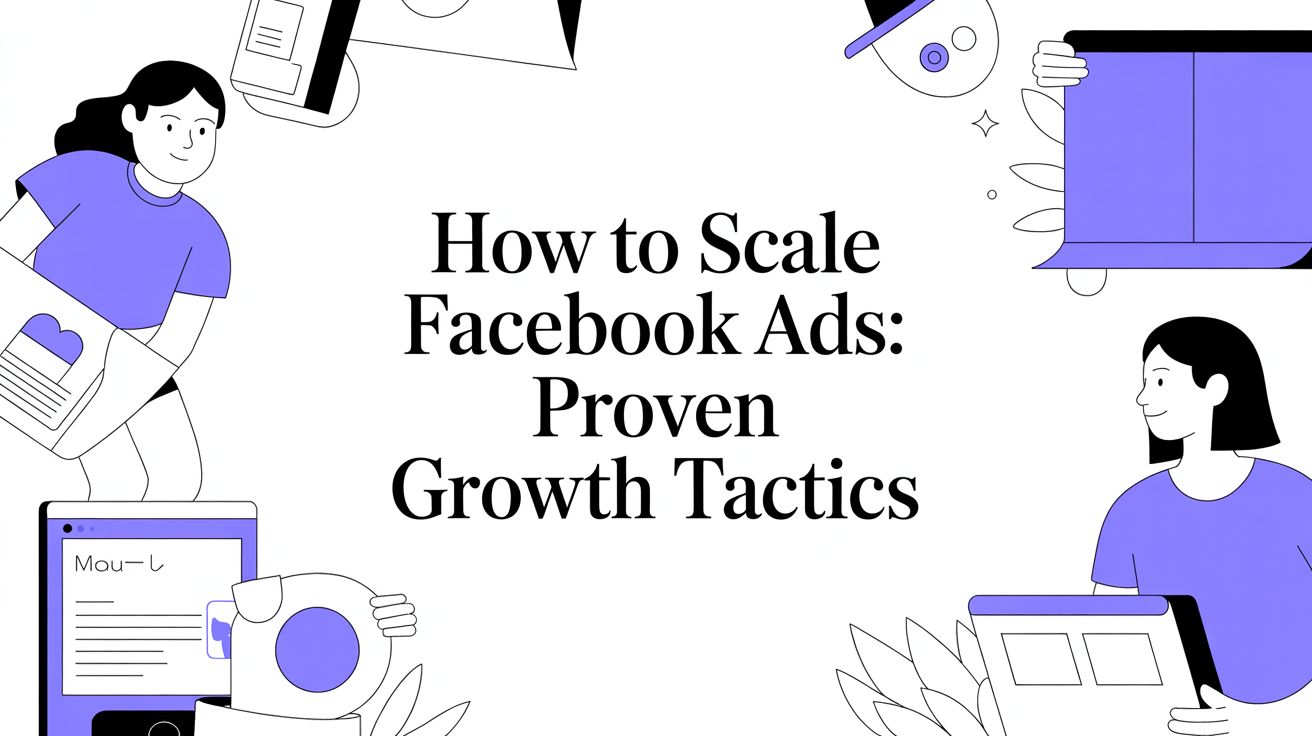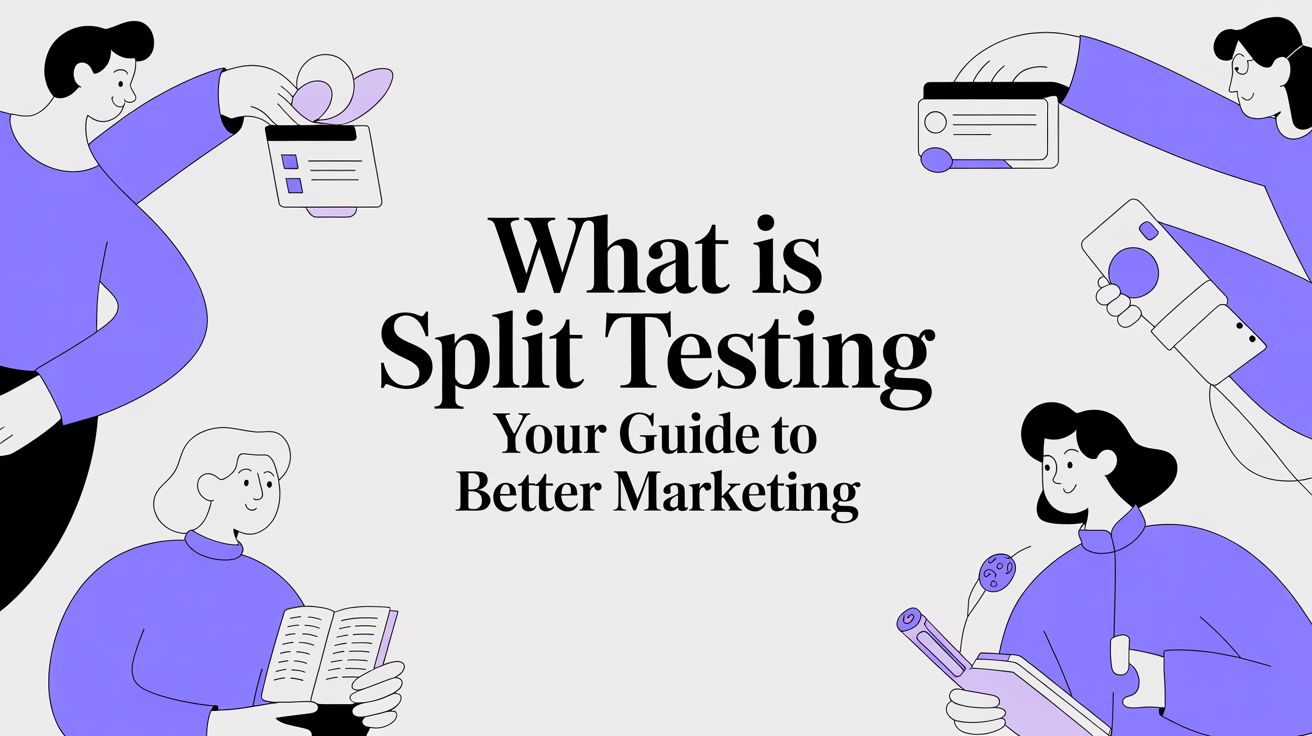So, what exactly is automatic video editing? In simple terms, it's using smart AI to take care of the heavy lifting in video production—things like cutting out pauses, generating captions, or adding background music. Think of it as a super-efficient assistant who handles all the tedious stuff, freeing you up to focus on the story you're trying to tell.
This approach makes creating professional-looking videos faster and much more accessible to everyone, not just seasoned editors.
Making Sense of Automatic Video Editing
If you've ever tried to assemble furniture with just a manual screwdriver, you know it's a slow, exhausting process. It gets the job done, but your wrist will be sore for days. Now, picture doing that same job with a power drill. You’re still in control, making the key decisions, but the tool does all the repetitive, hard work for you in a fraction of the time.
That’s exactly what automatic video editing is for content creators. It’s your power drill.
It’s not here to take over the creative process; it’s designed to boost it. The whole point is to let smart software handle the most time-consuming parts of editing. This means you can stop spending hours trimming dead air or manually creating subtitles and instead pour that energy into what really matters: your message, your brand, and your unique story.
Moving from Manual Grind to Smart Workflow
The difference between old-school editing and an automated approach is night and day. Traditional editing often means you're glued to your screen for hours, meticulously scrubbing through footage, making tiny cuts, and syncing audio by hand. An automatic platform can do much of this work in just a few minutes.
This isn't just a small step forward; it's a complete shift in how we approach video production.
The goal of automatic video editing isn't to create generic, cookie-cutter videos. Instead, it’s to provide a highly efficient foundation, giving creators more time and mental energy to spend on personalization, narrative, and strategic fine-tuning.
This efficiency is why the market is exploding. The global AI video editing market was valued at around USD 1.6 billion in the early 2020s and is projected to skyrocket to USD 9.3 billion by 2030. You can dig into more data on the AI video market growth to see just how fast this space is moving.
A Clear Comparison
To really see the difference, a quick side-by-side comparison can be helpful. Here’s a table that breaks down how traditional and automatic editing stack up against each other.
Traditional vs Automatic Editing at a Glance
| Aspect | Traditional Video Editing | Automatic Video Editing |
|---|---|---|
| Time Investment | Hours to days per video. | Minutes to a few hours. |
| Required Skill | High. Requires technical proficiency. | Low. Intuitive and user-friendly. |
| Core Tasks | Manual trimming, color grading, audio sync. | AI-powered cuts, transcription, effects. |
| Consistency | Varies by editor and project. | High, with consistent branding and style. |
| Cost | High (editor's salary, software licenses). | Lower (affordable subscription models). |
As the table shows, the core benefit is a massive gain in efficiency without sacrificing quality. This allows anyone, regardless of their technical background, to produce great content.
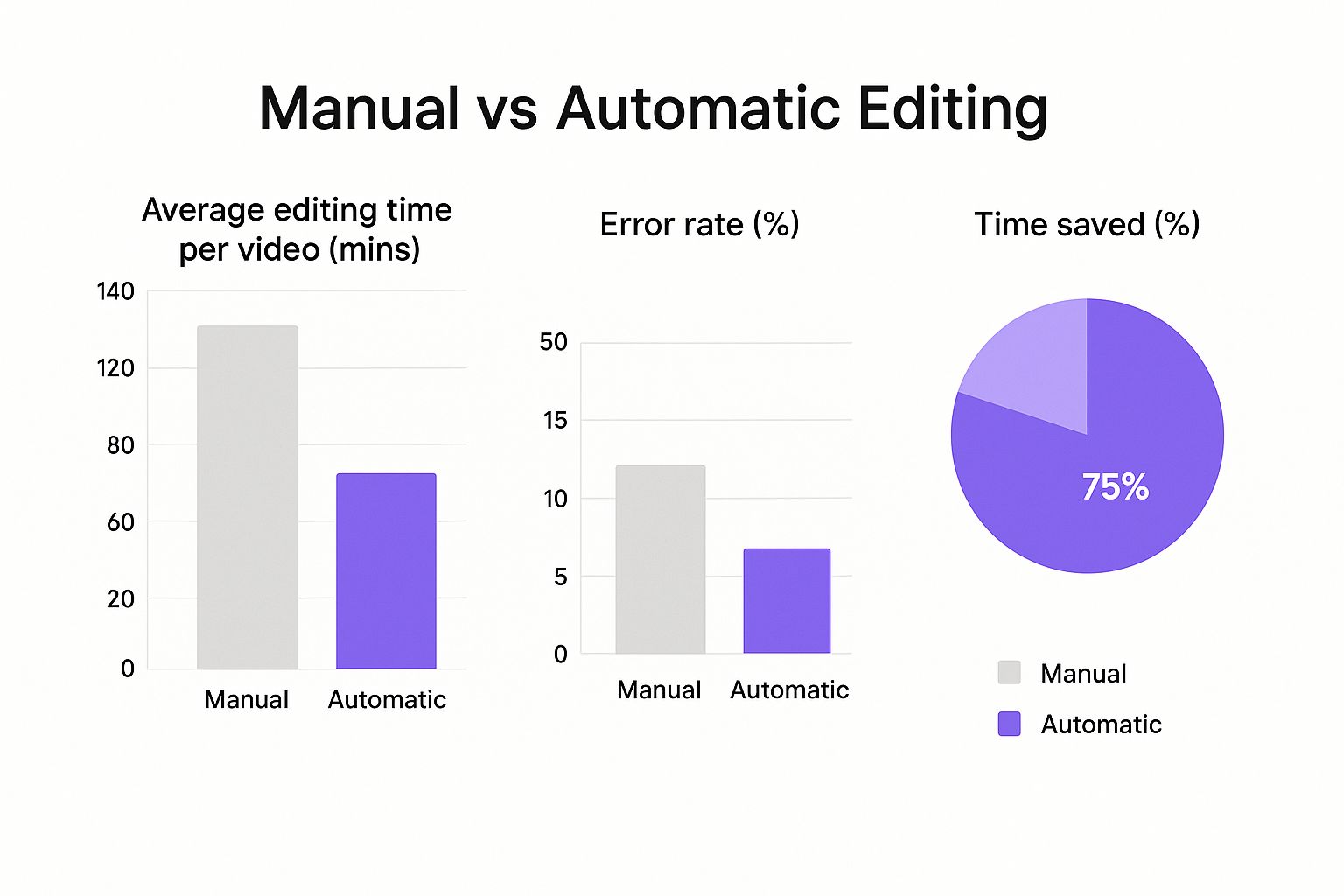
The numbers speak for themselves. Automated systems can cut down editing time by as much as 75% while significantly reducing common mistakes. This massive boost in productivity means you and your team can create more content, experiment with new ideas, and respond to trends faster—all without getting bogged down in the technical weeds.
How AI Changes the Editing Workflow
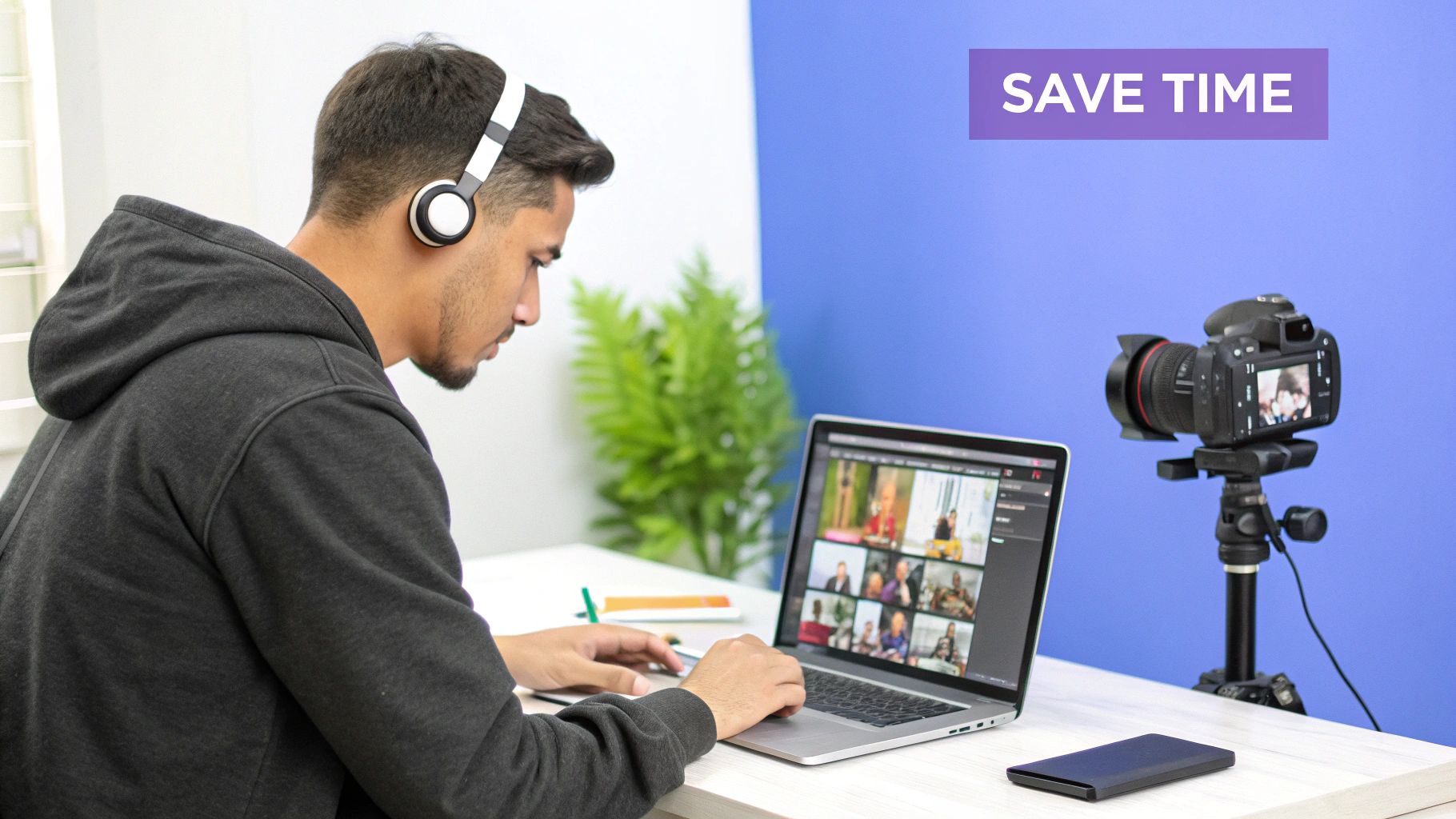
When we talk about automatic video editing, we're really talking about a few core AI technologies working together. Things like machine learning and natural language processing are the engines under the hood. They’re what allow a tool to listen to what you’re saying, pick out the important parts, and find the right visuals—all without you needing to do it manually.
So, how does this actually work in practice? It’s less about "magic" and more about smart algorithms tackling the tasks that used to eat up hours of our time. AI doesn't just make the old way of editing faster; it completely reinvents the process.
Let's walk through a real-world example. Imagine a marketer named Sarah needs to create a video for a new product launch. Traditionally, this was a multi-day ordeal: one day for shooting, another for logging all the footage, and a third day hunched over a timeline, piecing it all together. With AI, her workflow looks entirely different.
From Raw Footage to Polished Video
First, Sarah takes all her raw files—the main "talking head" video, some close-up shots of the product, and a few customer testimonials—and uploads them to the platform. Instead of sitting down to watch every second of footage, she lets the AI do the heavy lifting.
Almost immediately, the AI gets to work on several tasks at once:
- Automated Transcription: It processes all the audio and creates a full, time-stamped text transcript. This is a game-changer. Sarah can now edit her video by simply editing the text—deleting a sentence in the transcript removes that exact part from the video.
- Intelligent Scene Detection: The AI automatically finds and trims out the dead air, awkward pauses, and all those "ums" and "ahs." This instantly tightens up the pacing and makes the speaker sound more confident and professional.
- Keyword Analysis: As it analyzes the script, the system pinpoints the main topics. When Sarah’s script mentions “new features” or “customer success,” the AI flags these as key moments, making them easy to find later.
In just a few minutes, what was once a mountain of disorganized footage becomes a structured, easy-to-edit project. Sarah hasn't had to touch a single timeline or make a single cut herself. To get a deeper sense of these changes, it's worth exploring how AI is revolutionizing video editing across the board.
The real power of an AI-driven workflow is its ability to handle multiple complex tasks in parallel. It transcribes, cuts, and organizes simultaneously, achieving a level of efficiency that is impossible for a human editor to match.
Smart Asset Selection and Branding
Now, for the fun part. The AI uses its understanding of the script to suggest relevant B-roll footage. When the speaker talks about "increased productivity," the platform might automatically pull up stock video of a busy office or a graph with an upward trend.
Sarah can quickly review these suggestions, swap them out if she wants, or approve them with a click. The AI isn't just dropping in random clips; it’s finding visuals that are contextually relevant, making the final video much more engaging to watch.
Once the video's structure is set, the AI handles all the branding. Sarah has already set up a brand kit with her company's logos, fonts, and color scheme. The AI takes that information and applies it consistently across every lower-third graphic, title card, and subtitle. This ensures that even short clips made for social media have a polished, uniform look. In fact, many of the best AI video makers for TikTok depend on this feature to produce great-looking content quickly.
In less than an hour, Sarah has a finished, on-brand product video ready for final review. The automatic video editing platform took care of all the tedious work, freeing her up to focus on what really matters: the story and the message. This is the new standard—a workflow that's fast, smart, and accessible to everyone.
The Real-World Payoffs of Automated Video
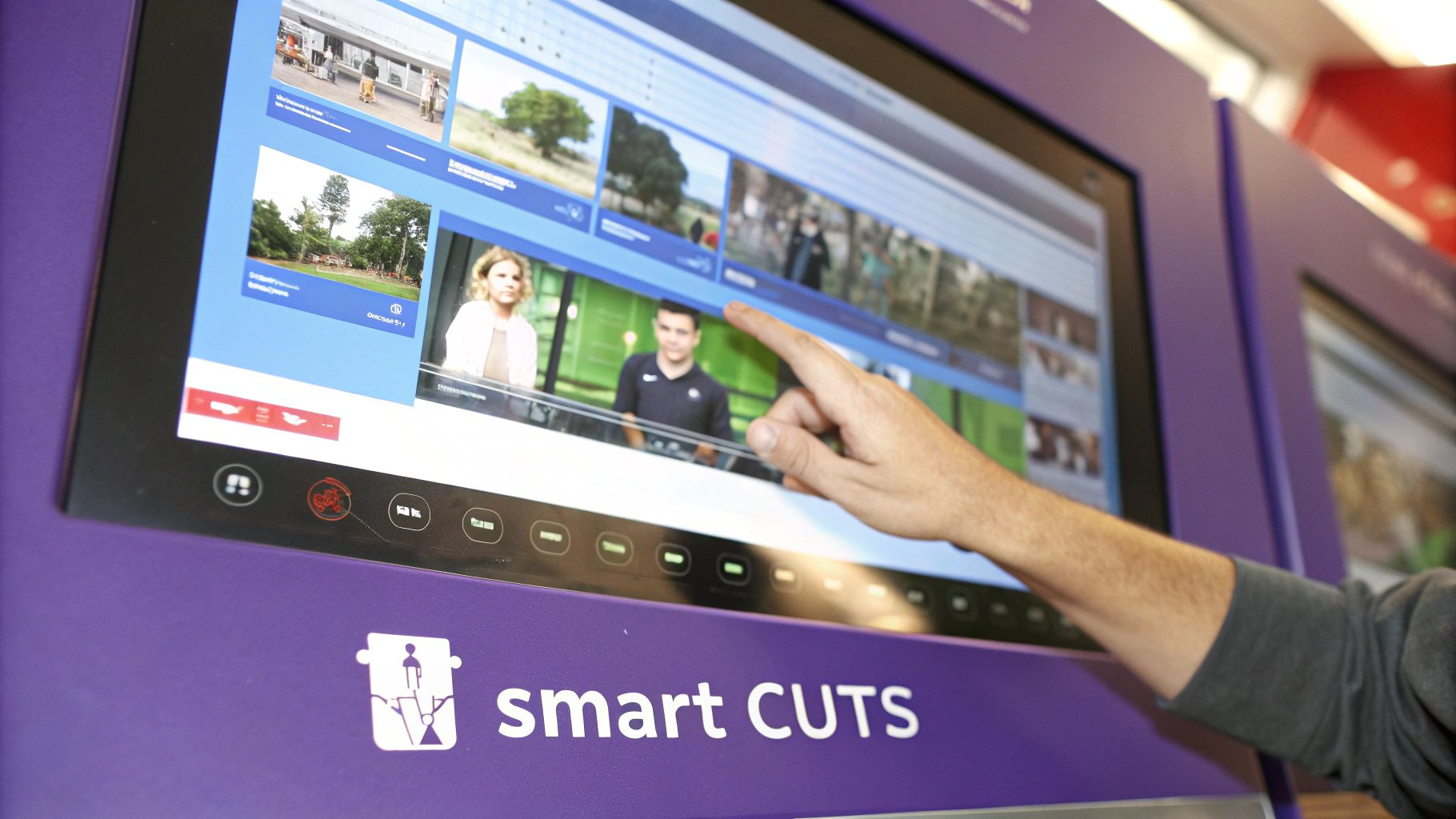
It’s one thing to understand the mechanics of automatic video editing, but seeing what it can do for a real business is where the magic happens. Bringing this technology into your workflow isn't just about getting a new tool; it's about completely changing what you can achieve with your content strategy. The benefits go way beyond convenience—they deliver real, measurable results in time saved, brand strength, and who can create content.
This shift is a huge reason why the video editing software market is growing so steadily. Valued at roughly $601.7 million in 2025, the market is expected to grow by about 8.7% each year through 2033. This growth is all about the increasing demand for video tools with AI features that handle the heavy lifting. You can dig deeper into the growth of the video editing market to see how this trend is playing out across the industry.
Reclaiming Your Most Valuable Asset: Time
The most immediate win you'll see with an automatic video editing platform is the sheer amount of time you get back. For any team that puts out content regularly, this is a total game-changer.
Think about a marketing team producing a weekly video series for social media. With traditional editing, that process could easily chew up 8-10 hours of someone's week—syncing clips, mixing audio, adding captions, and dropping in brand assets. An automated system can shrink that entire workflow down to under an hour.
That’s not just a small efficiency boost. Over a single month, that team gets back over 30 hours of precious time. That’s time they can now pour into bigger-picture tasks like brainstorming new campaigns, digging into analytics, or actually talking to their community.
Achieving Unbreakable Brand Consistency
Keeping a consistent brand look and feel across all your videos is a huge headache, especially in bigger companies. When you have different people in different departments making videos, the styles can get messy fast, and that dilutes your brand's voice.
Automatic video editing offers a simple, elegant solution. You set up a brand kit once—with your company's logos, color palettes, and fonts—and you guarantee that every video that comes out of the system looks exactly how it should.
Imagine a company creating dozens of internal training videos. Instead of each one looking slightly different, an AI-powered tool can apply the same polished, branded template to every single one. This creates a professional, cohesive experience for employees and reinforces the brand from the inside out, all without any extra work from the creators.
The real power of automated branding isn't just about looking good; it's about creating a predictable, reliable, and trustworthy visual experience for your audience, whether they are customers or internal team members.
Making Video Creation Accessible to Everyone
Maybe the most important benefit is how it opens up video creation to everyone. Not too long ago, making a high-quality video was a skill reserved for people with technical chops and expensive software. Automatic video editing completely levels the playing field.
Take a small business owner who has a fantastic product but zero video editing experience. Now, they can shoot some raw footage on their phone, upload it, and let the platform do the rest. It automatically cuts out awkward pauses, adds perfectly timed captions, and wraps it all in a professional template.
Suddenly, that small business can produce marketing videos that look just as good as those from much bigger companies. They're no longer held back by budget or a lack of technical skills. This accessibility empowers all kinds of creators to share their stories, connect with their audience, and grow their business through video. Of course, once the video is made, getting it seen is the next step, which involves choosing the right video distribution platforms to reach your target audience effectively.
How to Choose the Right AI Video Platform
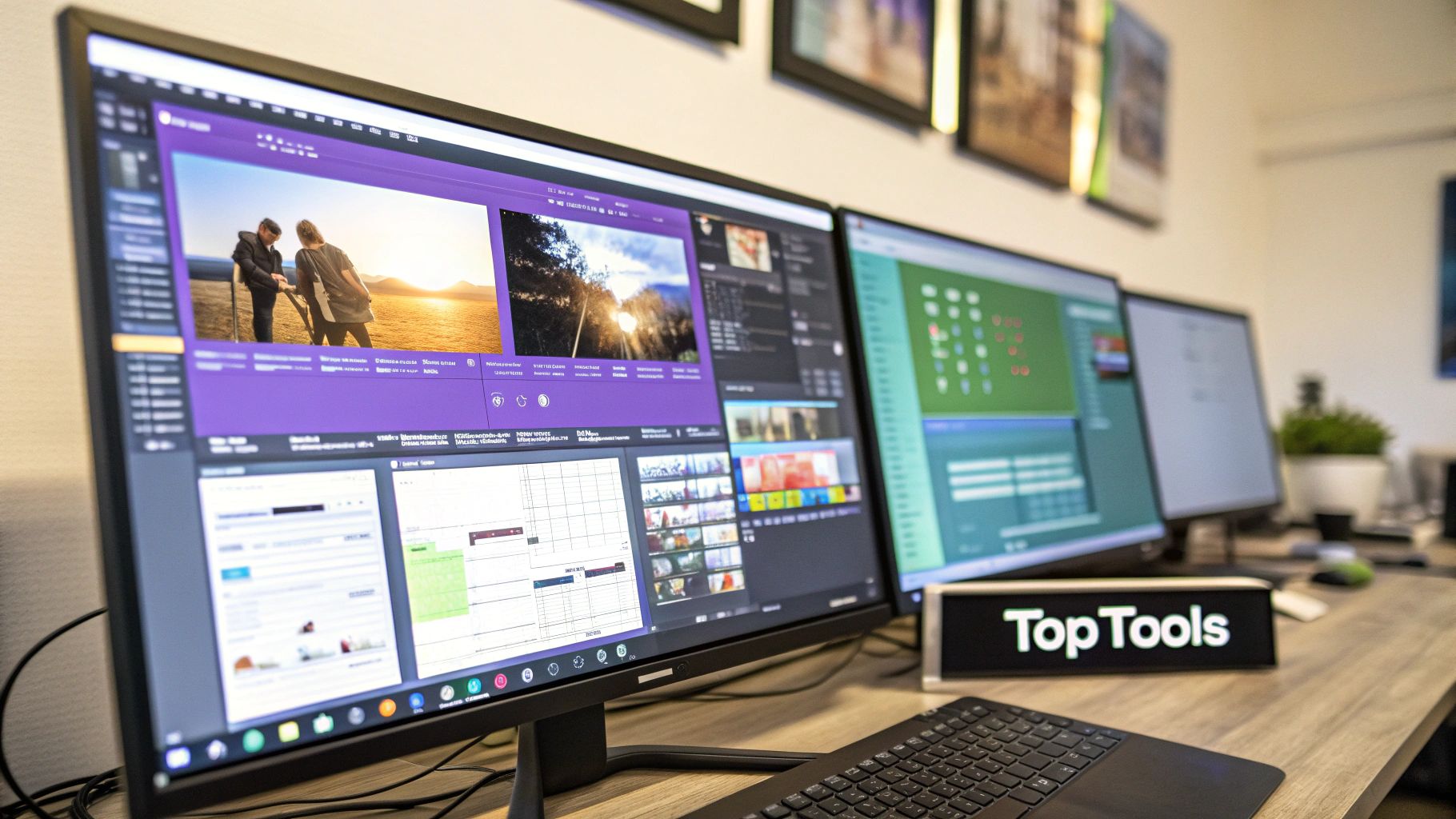
With so many AI video tools popping up, trying to pick the right one can feel like a guessing game. The secret is to ignore the buzzwords and focus squarely on what you actually need to accomplish. The "best" tool isn't always the one with the longest feature list—it's the one that slots into your existing workflow and gets you to the finish line faster.
To cut through the noise, it helps to have a simple checklist. Think of it as your guide for comparing options. By focusing on a few key areas, you can quickly tell which platform will be a genuine partner in your creative process.
Evaluate Core Features and Usability
First and foremost, how easy is the platform to use? A tool with endless capabilities is worthless if it takes weeks of training just to figure out the basics. Look for a clean, intuitive interface that makes it simple to upload footage, apply edits, and export your final video without a headache.
Beyond that, think about creative control. Does the AI make suggestions you can tweak, or are you stuck with whatever it spits out? The sweet spot is a platform that handles the tedious, repetitive tasks for you but leaves the final creative calls in your hands. A great example is how a platform like Sprello uses AI to generate UGC-style ads but lets you customize everything from voiceovers to avatars. That way, the end product is still uniquely yours.
Check for Integrations and Customization
Your video tool shouldn't be an island. See if it plays well with the other software you use every day. This could be anything from direct access to stock footage libraries to seamless connections with your social media schedulers or project management apps. Smooth integrations mean less time spent awkwardly jumping between different programs.
Also, look at how much you can personalize the platform. A solid automatic video editing tool will let you build and save brand kits with your specific logos, fonts, and color palettes. This is a game-changer for keeping your videos consistent and instantly recognizable. The ability to create templates for recurring content like tutorials or social ads is another huge time-saver. You can see how templates accelerate the process in our guide on how to create AI video ads.
The right platform doesn't just automate tasks; it learns your brand. Strong customization features transform a generic tool into a specialized assistant that understands and applies your unique visual style.
Understand the Pricing and Scalability
Finally, take a hard look at the price tag. Make sure the costs are clear and fit within your budget. Most platforms use a subscription model, so dig into what each tier actually offers. Pay close attention to any limits on video exports, storage space, or access to premium features. A free trial is the perfect way to take a platform for a test drive before you commit.
This is more important than ever. By 2025, the paid user base for video editing software is projected to reach 48.22 million, with about 85% of businesses using video in their marketing. That kind of growth means you need a tool with pricing that can scale with you. If you want to dive deeper, you can explore some of the 12 Best Video Editing Automation Tools to see how different platforms stack up.
Selecting Your AI Video Editing Tool
Choosing the right tool ultimately comes down to what you're trying to create and your comfort level with technology. To make it easier, this table breaks down the common types of AI video platforms to help you find your perfect match.
| Platform Type | Best For | Key Features | Example Use Case |
|---|---|---|---|
| Template-Based Editors | Quick social media content and simple ads. | Pre-made templates, drag-and-drop interface. | A small business creating a promotional Instagram Reel. |
| Text-Based Editors | Repurposing long-form content like podcasts and webinars. | Editing video by editing a text transcript. | A podcaster creating shareable clips from an interview. |
| Generative AI Platforms | Creating new video content from scratch using AI actors. | AI avatars, text-to-video, voice cloning. | A marketing team producing training videos without filming. |
| Full-Suite AI Editors | Creative professionals who want AI-assisted workflows. | AI-powered scene detection, B-roll suggestions, automated color grading. | A video editor speeding up the rough cut for a client project. |
By aligning a platform's strengths with your specific goals, you'll be well on your way to picking a tool that not only saves time but also elevates your content.
Integrating AI Into Your Content Workflow
https://www.youtube.com/embed/R8yEvQ0lx-s
Bringing an automatic video editing tool into your process isn't just about adding another piece of software. Think of it as upgrading your team’s entire creative engine. The real magic happens when you see it as a partnership: AI takes over the repetitive, soul-crushing tasks, which frees up your team to focus on what humans do best—strategy, storytelling, and making high-impact creative calls.
This approach means you get the best of both worlds. Your production becomes incredibly efficient, but the final video is still guided by human instinct and a deep understanding of your brand. The goal is to let the machine handle the grunt work so your team can focus on mastering the message. This shift allows you to create more content, way faster, without losing that unique touch that makes your brand yours.
Building Your Automated Foundation
The first step is to build a solid foundation so consistency becomes second nature. This is where brand kits and templates are your best friends. By setting these up from the get-go, you guarantee that every piece of content—from a quick social clip to a detailed tutorial—is perfectly aligned with your brand identity.
- Create a Comprehensive Brand Kit: This is your brand’s rulebook for the AI. Upload your logos, plug in your exact brand color codes, and set your primary and secondary fonts. A good platform like Sprello will use this kit to automatically brand every video it creates, making each one instantly recognizable.
- Develop Reusable Templates: Think about the video formats you make all the time. Is it weekly social media updates? Customer testimonials? Product demos? Build a template for each one with pre-set structures, title card styles, and spots for your calls-to-action.
Putting in this work upfront pays off big time down the road. Instead of building every video from the ground up, your team can just pick a template, drop in the new footage, and let the AI assemble a polished, on-brand video in minutes.
The best AI tools don't force you to change your process; they remove the friction from it. By setting up brand kits and templates, you’re essentially teaching the AI your brand’s rules so it can act as a natural extension of your team.
Empowering Your Team for a Hybrid Future
Getting your team on board is everything. When you introduce automatic video editing, don't position it as a replacement for their skills. Frame it as a powerful amplifier. The AI handles the 80% of tedious work—like trimming out silences and adding all those captions—so your people can pour their energy into the critical 20% that truly matters. That's the creative polish, the narrative tweaks, and the final sign-off.
Encourage a "test and learn" attitude. Start with some low-stakes projects to let everyone get a feel for how the platform works and what it can do. If you want to go deeper on streamlining your whole production line, it’s worth thinking about how to build an optimized content creation workflow where these automated tools fit in naturally. This human-AI partnership isn't just a trend; it's the future of making content that is more efficient, creative, and impactful.
Frequently Asked Questions
It's natural to have questions when a new technology like automatic video editing comes along. I hear a lot of the same concerns from creators and marketers—worries about losing creative control, whether videos will look generic, or even if it means human editors are out of a job. Let's tackle these head-on.
Getting straight answers will help you see where these tools really fit and how you can actually use them to your advantage.
Will AI Make My Videos Look Generic?
This is a big one. Nobody wants their content to look like it came off an assembly line. The fear is that AI will just pump out cookie-cutter videos that all look the same.
Thankfully, the best platforms are built to avoid this by putting your brand front and center. Think of the AI less like a robot and more like a very fast assistant who needs to learn your specific style. You teach it by setting up a brand kit—uploading your logos, plugging in your exact brand colors, and choosing your fonts.
Once you do that, every video the AI assembles is built on your unique brand identity. The machine does the heavy lifting, but your creative DNA is what holds it all together.
How Much Control Do I Really Have?
This is the make-or-break question for most creatives. The good news is that you're not just handing over the keys and hoping for the best. Modern tools are designed to be a collaboration. They aren't black boxes that spit out a finished product with no input.
Instead, the AI gives you smart suggestions that you can tweak, approve, or completely ignore. It might suggest cutting a pause here or adding a certain B-roll clip there, but you always have the final word.
The whole point is to give you control where it counts—the story, the message, and the creative details—while automating the grunt work that doesn't need a human touch, like trimming dead air or creating captions.
You’re still the director. The AI is just your incredibly efficient first assistant editor.
Does This Technology Replace Professional Editors?
I get this question all the time, and the answer is a firm "no." Automatic video editing doesn't replace skilled professionals; it elevates them. It acts as a powerful sidekick, handling the most tedious and repetitive parts of the editing process.
This actually frees up human editors to spend their time on what they do best—the stuff a machine can’t touch:
- Complex Storytelling: Weaving a narrative that connects with people on an emotional level.
- Creative Problem-Solving: Coming up with clever visual ideas to explain tricky concepts.
- Strategic Direction: Making sure the final video doesn't just look good, but actually achieves its goals.
So, instead of spending hours on tedious cuts, an editor can focus on being a creative strategist. That makes them more valuable, not less.
Ready to see how fast and easy video creation can be? Sprello uses AI to help you create high-performing, UGC-style video ads in minutes, not hours. Start your free trial and transform your content workflow today at https://sprello.ai.


